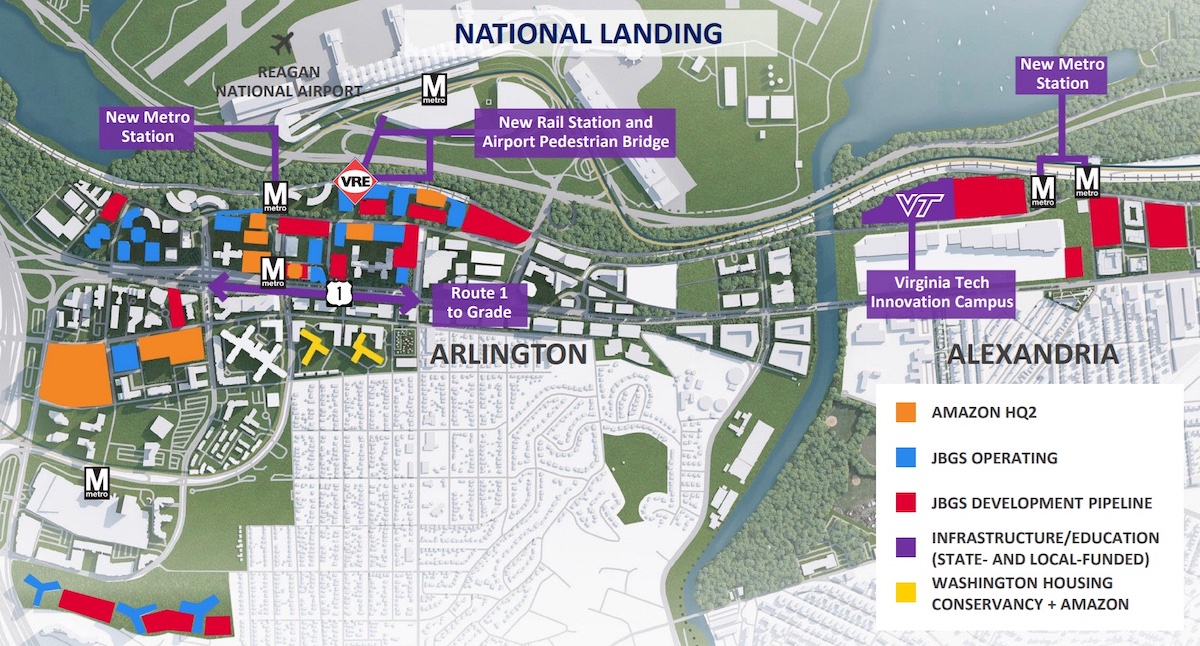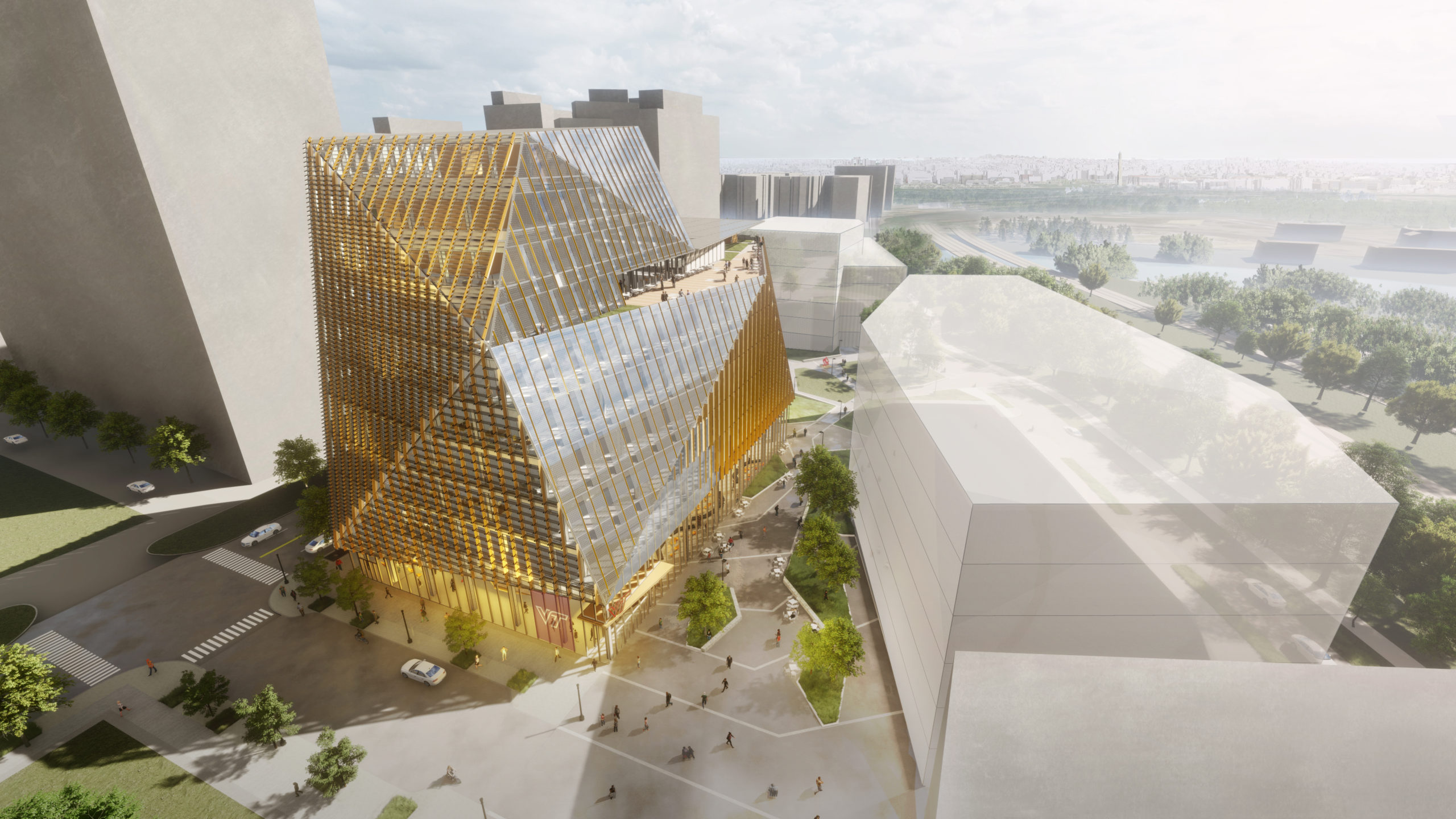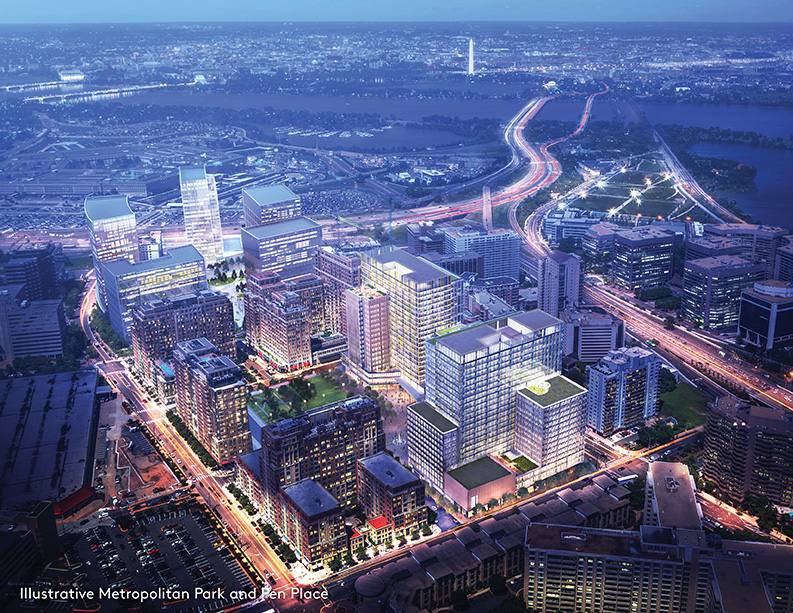With tenants like tech giant Amazon plugging full steam ahead on HQ2, Virginia’s National Landing neighborhood is already making a splash in the DMV tech scene. But what does hosting a headquarters, creating a smart city and building thousands of flashy apartment buildings really mean for a local tech sector?
National Landing — the name for the neighborhood slowly being built over in Arlington, Virginia — has been nearly synonymous with any news about the new Amazon headquarters. That’s been even more so the case since the county its final stamp of approval on the HQ2 plans last month, while the company aims to complete the project by 2025. But while it’s been the project’s darling so far, the developer behind National Landing has much larger plans. Several involved players hope National Landing could potentially be the next tech innovation spot, similar to Kendall Square in Cambridge, Massachusetts or South Lake Union in Seattle, Washington.
Jack Kelly, a vice president of National Landing real estate developer JBG SMITH, wants the neighborhood to not only house Amazon and other existing companies but facilitate new ones as well.
“How do we attract the next Amazon?” Kelly told Technical.ly. “How do we make sure that the people, at some point, will leave Amazon to start their own companies? How do we create that environment for them?”
Kelly said that most of Crystal City was developed in the 1960s-70s, with few updates since. He hopes to be strategic about growing housing options, including multifamily ones. The developer has also sought a balance of spaces and products being brought to market through the project.
“We’re long-term holders of real estate and so we have a different calculus as to how we look at these types of things, because we don’t buy and sell buildings like a merchant developer might,” Kelly said. “We’re going to own this real estate for a long time.”
What’s what in the build

Developer JBG Smith’s 2021 map of National Landing in Arlington, Virginia. (Courtesy image)
JBG already has many plans for National Landing. Workers are set to start building a new Crystal City Metro stop entrance next year, while a new Potomac Yard station should open later this year. Construction of the Virginia Tech Innovation Campus, which broke ground in 2021, is expected to wrap in 2024. JBG also intends to start developing a pedestrian bridge to the airport, a multi-mode transit hub and Route One alterations in 2027, 2025 and 2025, respectively.
Another large portion of National Landing will focus on housing. 1900 Crystal Drive, which will include over 800 units, and 2000 to 20001 South Bell, which incorporates 775 units and some retail space, are already underway. Additional expected projects will add at least 1500 residential units, leading to around 7,900 total housing units.
This housing focus is somewhat uusual for innovation districts. A study from the National Landing Business Improvement District notes that innovation districts tend to be about 25% to 50% residential, while National Landing expects a near 1:1 ratio of 23,000 daytime workers to 22,000 residents (not including another 7,000 nighttime employees). By comparision, the report says that downtown DC has about a 9.6 ratio for daytime workers.
“This urban vibrancy will attract employers seeking to compete ‘on place’ and locate near a significant residential presence,” the report reads.
Amazon also created a $2 billion Housing Equity Fund to help address affordable housing needs. But The Washington Post found that the fund has not yet done much to accomplish its goal. According to the outlet, only 6% of units have been earmarked for the lowest-income renters so far, with fund director Catherine Buell saying it’s really designed for workers who make too much to qualify for many public benefits programs but still cannot afford area housing costs. But at present, only 215 units have been set aside for residents making under 50% of the local median income, the Post reported. Amazon also just agreed to contribute $55 million in low-rate loans for affordable housing in Tysons, Virginia.
A New Tech Hub

A rendering shows academic building concepts for the Virginia Tech Innovation Campus. (Courtesy photo)
National Landing’s mixed-use intentions do not negate tech’s true importance to the build.
JBG hopes that the 5G network it prioritized will draw technologists and companies alike. Last summer, the developer inked a letter of intent with AT&T to create a 5G-powered smart city, which will allow wireless coverage anywhere in the area.
Kelly finds physically updating the area to be both “capital-intensive” and “disruptive” (in a good way) for production. In fact, he called it a real opportunity for companies and jurisdictions to augment the infrastructure.
“We’re really trying to marry up that availability of technological infrastructure with the things that the employees will want and need on an everyday basis,” Kelly said.
Kelly also wants more universities and institutions to establish a presence there and create a talent pool for the companies to draw from. And they might need it: Amazon has already committed to adding 25,000 new employees to HQ2 (it hit the 5,000 mark a few weeks ago) by 2030.
But at present, it’s unclear just how many of those jobs will go to local residents. Amazon’s national ties, remote-friendly abilities and ability to cherry-pick the best candidates from anywhere offer many chances to hire talent from outside the region. The Virginia Tech talent pool is only a small slice of the many positions to be filled from companies that could come from anywhere. To accommodate the new hires, Kelly says that National Landing is set to host almost 7 million square feet of office space, although the BID report put that number at 8 million.
“What we see with tenants like Amazon [is that] businesses and entrepreneurs and startups like to locate around companies like Amazon,” Kelly said. “I think that’s kind of a given, and we’ll start to see that over the next several years if they deliver their office space.”
Altogether, Kelly said that JBG feels strongly that the anchors it’s offering at National Landing will put the area in an advantageous position before tech companies. He even hopes that it could model how similar strongholds and neighborhoods get built going forth.
No matter how the project turns out, Kelly emphasized that JBG is not working alone. With such a huge amount of space, homes and offices, the project is only happening with the cooperation of Arlington County and the City of Alexandria.
“One thing we’ve really learned as part of the Amazon bid is that it really does require both public and private participation in making these types of places work,” Kelly said.
Before you go...
Please consider supporting Technical.ly to keep our independent journalism strong. Unlike most business-focused media outlets, we don’t have a paywall. Instead, we count on your personal and organizational support.
Join our growing Slack community
Join 5,000 tech professionals and entrepreneurs in our community Slack today!





